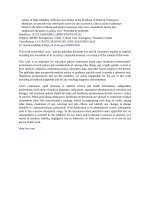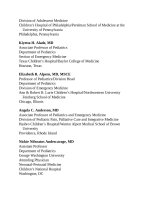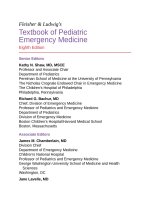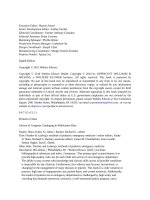Pediatric emergency medicine trisk 2709 2709
Bạn đang xem bản rút gọn của tài liệu. Xem và tải ngay bản đầy đủ của tài liệu tại đây (106.74 KB, 1 trang )
markers, pain, and swelling over the involved bone. Benign tumors of bone account
for half of the bone tumors in children and include giant cell tumor, eosinophilic
granuloma, and aneurysmal bone cysts. Benign lesions usually have smooth, welldefined borders on plain radiographs and rarely have associated soft tissue masses.
Symptoms of malignant bone lesions commonly include pain at the tumor site (in
80% to 90% of cases), soft tissue swelling, and/or a painful limp. The pain may
wake the patient at night in some cases (less than 25%).
FIGURE 98.3 Two plain radiographs demonstrating osteosarcoma of the distal femur.
Clinical Assessment
Diagnostic evaluation in the ED should include a thorough history and physical
examination. Though there is frequently a history of trauma in retrospect, pain may
be intermittent and nondescript for weeks or months. Constitutional symptoms or
signs, such as fever, fatigue, and weight loss may occur with Ewing sarcoma/PNET.
If tumor is present in an extremity, a hard mass may be felt. Osteosarcoma usually
involves the metaphyseal end of long bones, most commonly around the knee or
proximal humerus. Ewing can occur in any bone but tends to involve the diaphysis
when in a long bone. An extremity with a bony mass should be completely
examined with careful attention to pulses, perfusion, range of motion, and sensation.
Compartment syndrome may develop due to swelling or bleeding within the mass.
Pelvic lesions often produce no specific physical findings. Lesions of the vertebral









